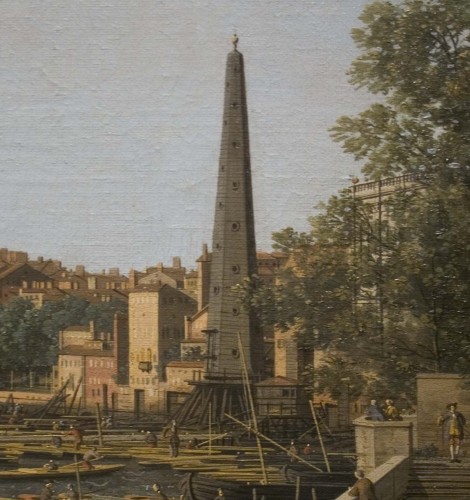Around 1750, Canaletto painted a scene of London from Somerset House towards Westminster. It shows all the obvious things you would expect to see… Westminster, St John’s, Smith Square, Banqueting House, the river, boats, etc.
I saw it at the Queen’s Gallery earlier today. But what is that odd wooden obelisk?
The design appears to have a door at the base, but is far too narrow to ascend to the top, and yet there are plenty of windows all the way up, suggesting something, or someone wants and needs air.
It’s also built, expensively over the river on large stilts.
A slightly different view is here.
My initial guess was that it is a pigeon house, built over the Thames so that pigeon waste can fall down into the river and saving the cost of having it cleaned away by hand. The narrow structure seems to fit the idea.
However, it is just an educated guess.
And totally wrong!
It is in fact a water tower.
The York Buildings Waterworks’ Water Tower was in fact a major landmark at the time, being some 70 feet high. It was erected in the late 17th century on a site at the end of Villiers Street, by the York Watergate, which is now part of the Victoria Embankment Gardens.
It probably stood about here, next to the entrance to Gordon’s Wine Bar. Water into wine!
Originally erected by Ralph Bucknall and Ralph Wayne in 1675-76 it’s function was to provide water pressure for the houses along the Strand. Like all subsequent water towers, it probably had a heavy weight at the top that pushed a plunger down the water pipes to increase the pumping pressure.
That way if lots of water was used at once, the pressure of the water supply could be maintained.
The original water tower was destroyed by fire in 1690 (probably used steam to raise the weight to the top) and the octagonal tower we see above was then constructed.
The York Buildings Company was able to supply water to 2,500 houses at its peak.
It also appears that in 1755, the engines were abandoned in favour of horses to pump the water.
I presume it lasted until 1862, when the modern Embankment was constructed, which would have cut off its supply from the Thames.
So that’s another landmark I learnt about today. And totally by accident, which is often the best way of learning about things.









Are you sure it wasn’t the spire of an underwater church?
…
There is a smaller decorative structure on the edge of the gardens. Just on the right if you are heading north up Villiers St. Possibly on top of the bandstand buildings, i can’t quite picture it in my head. I think it’s there as a reminder of he water tower.
Having been to the Canaletto exhibition in Bath today I too came away from it wondering just what it was…I felt it was not too narrow to go up, I just didn’t know why you’d want to…it doesn’t have a viewing platform like the earlier built monument to the Great Fire of London, the windows don’t really look like they would give a decent view at any point…..
But I googled ‘Canaletto Thames’ images and this page provided the answer, thank you
My mum went to a Canaletto exhibition in Kendal last week and also commented on this strange tower which someone told her was a water tower. I was researching it for her and this article is brilliant – exactly what we wanted to know. Thank you so much.
Renzo Piano says its depiction in another of Canaletto’s paintings, where it seems to loom upwards, was his inspiration for The Shard.
I read interviews with Renzo Piano and he clearly stated that The Shard was a reference to the many church spires of London
It seems unlikely that a fire of 1690 might have been caused by a steam engine as Savery’s steam pump — which is what L.T.C. Rolt and J. S. Allen say was installed — wasn’t patented until 8 years later.
See references etc to this article. https://en.wikipedia.org/wiki/York_Buildings_Company
I’ve never heard of the heavy weight approach with a plunger, I thought all water towers relied simply on raising the water to a height storing the water with a higher GPE so that it could then be supplied at pressure at ground level. But the design of that tower is definitely not suited to storage at height.
Not sure how many steam pumps were available in 1690 though. Thomas Savery was successful in the last couple of years of the 17th century.